SEO
7 Fast Ways to Increase Organic Traffic
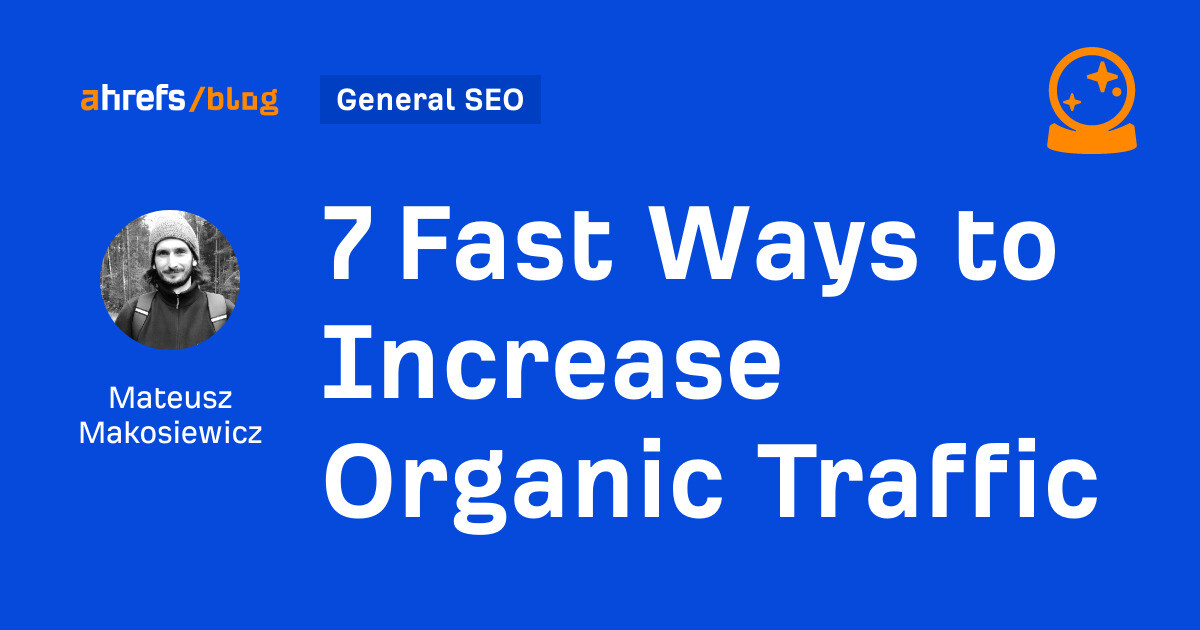
In the long term, the way you get more organic traffic is this: create more content about stuff people are searching for and build links. The problem is that it takes time.
If you want to get more organic traffic fast, you need to squeeze more juice out of what you already have. These seven tactics will show you how.
If people searching for your topic want fresh information, you’ll lose traffic and rankings if you don’t update your page. Google will simply rank pages with fresher content above you.
On the bright side, this traffic is usually easy to reclaim. All you need to do is replace the old with the new and remove any stuff that is no longer relevant.
For example, people searching for industry statistics don’t want facts from years ago. That’s why our curated lists of industry statistics usually get a boost in traffic when we update them. And it’s less than a day’s work to revisit the stats and replace them if needed.

Here’s how to find pages with the biggest traffic drops over the last six months in Ahrefs:
- Open Site Explorer and enter your domain.
- Go to the Top pages report.
- Set the Traffic filter to Declined.
- Compare with the previous six months and sort the Traffic Change from high to low.
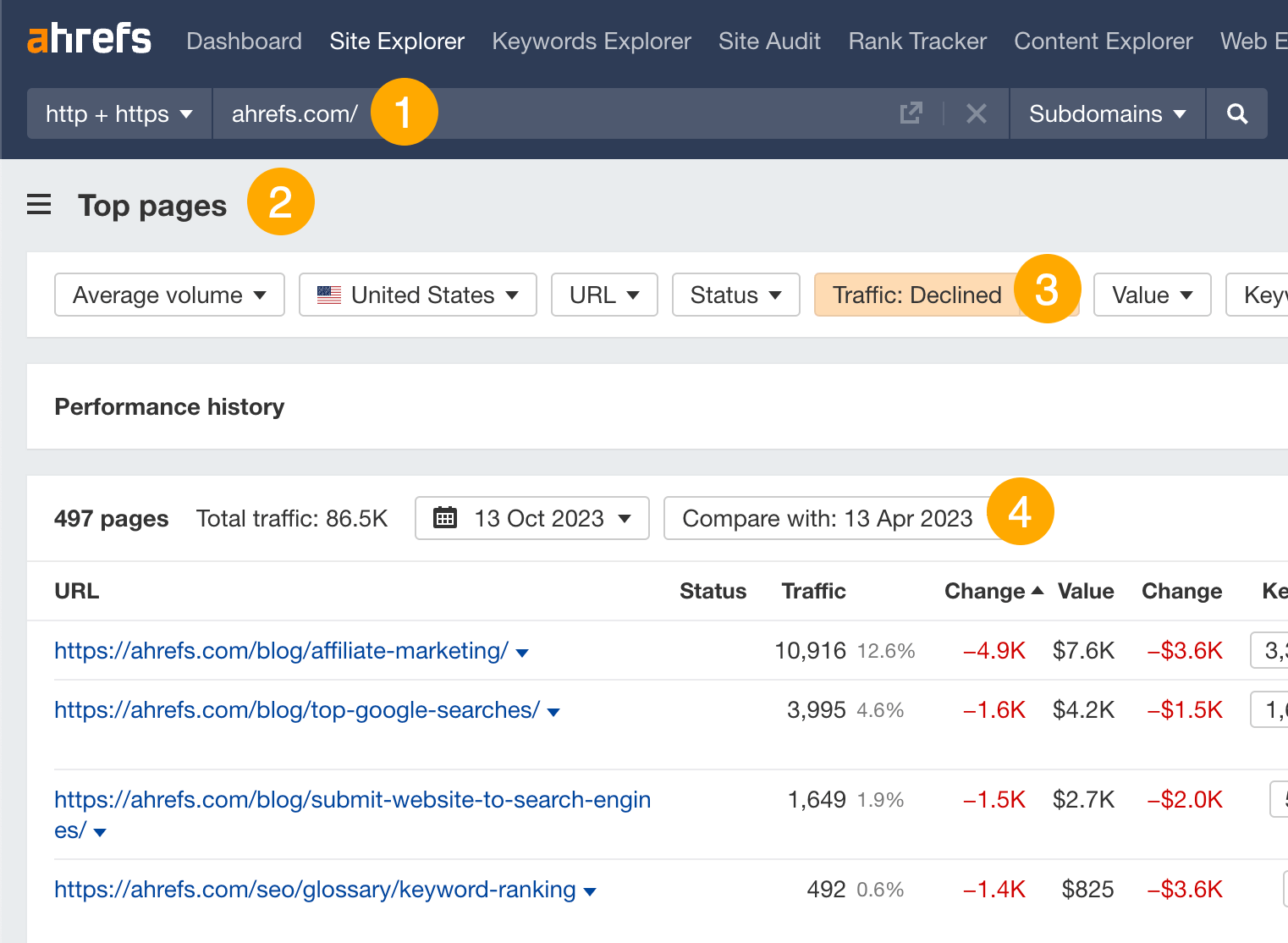
From here, you can eyeball the list for topics where searchers would expect fresh information and update them. Our page on “top Google searches” is a good example because searchers don’t care what people searched for in 2021. They want to know what’s popular today.
Dead pages are pages that no longer exist on your site. If they have backlinks, this is a huge waste of link equity.
Usually, backlinks are slow and hard to get. After all, they’re one of the strongest ranking factors. But with this technique, you’re in control of the backlinks—so you can give your SEO a boost fast.
- Go to Ahrefs’s Site Explorer and enter your domain.
- Go to the Best by links report.
- Add a 404 filter.
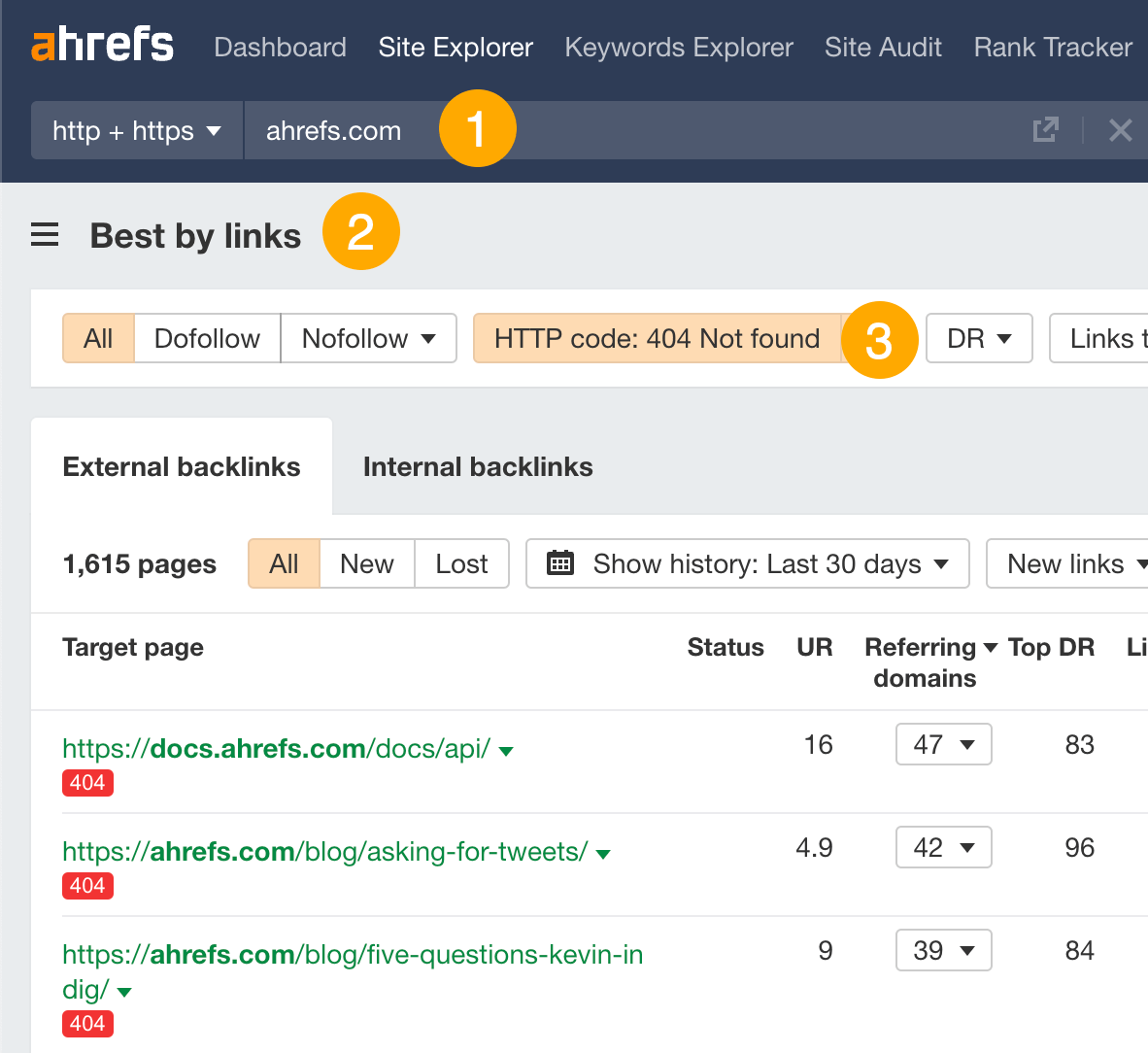
Next, redirect these broken pages to relevant live pages on your site. If a page has been removed by accident, consider reinstating it. The whole process goes like this:
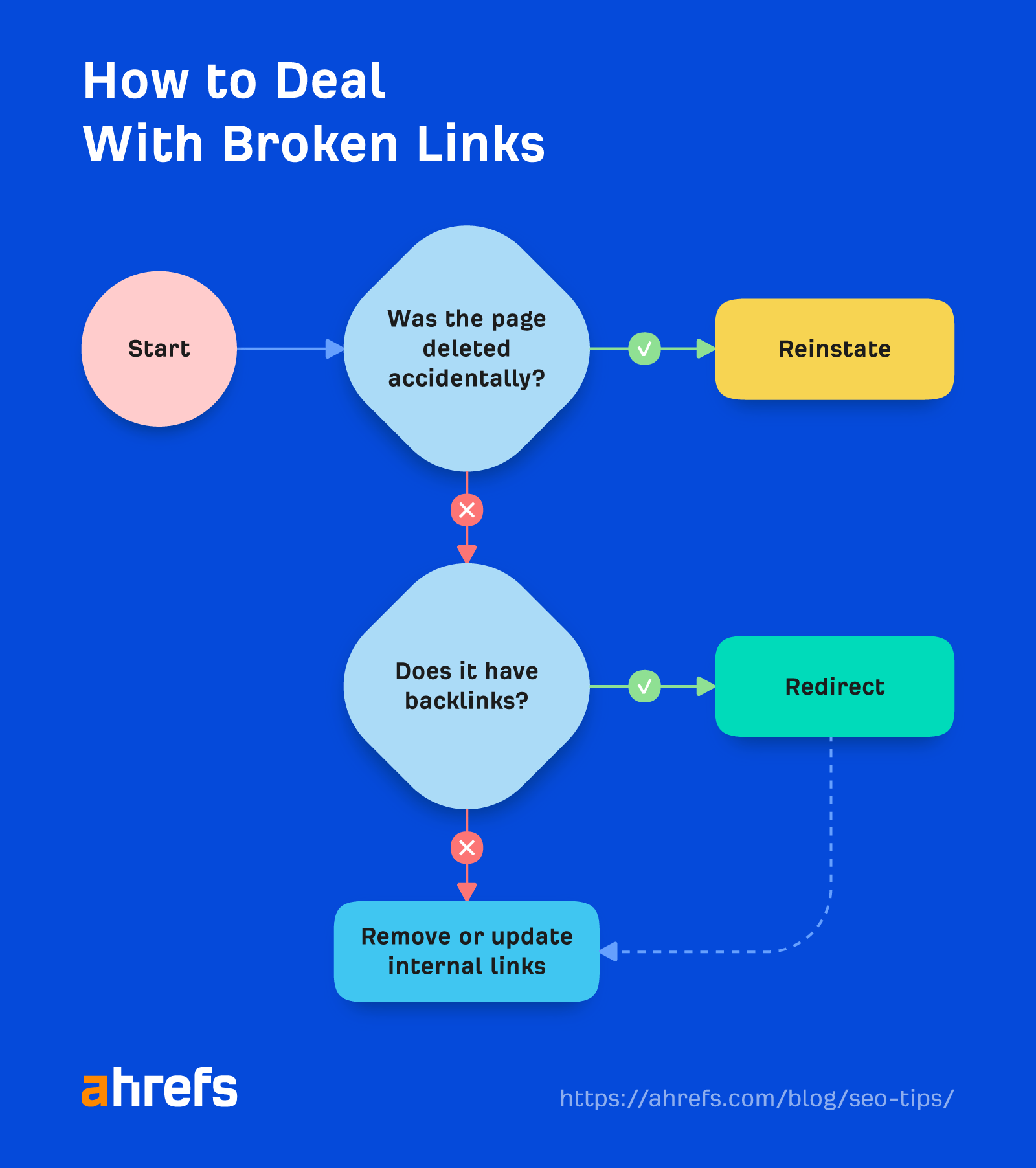
Not sure how to do a redirect? Read our guide to redirects for SEO.
Internal links are links from one page on the same domain to another.
One of their main roles in SEO is that they aid the flow of PageRank (aka “link equity”). This means that you can use internal links to give pages on your site an SEO boost.
For example, we’ve linked from our free backlink checker tool to some of our articles on link building with the aim of boosting their rankings.
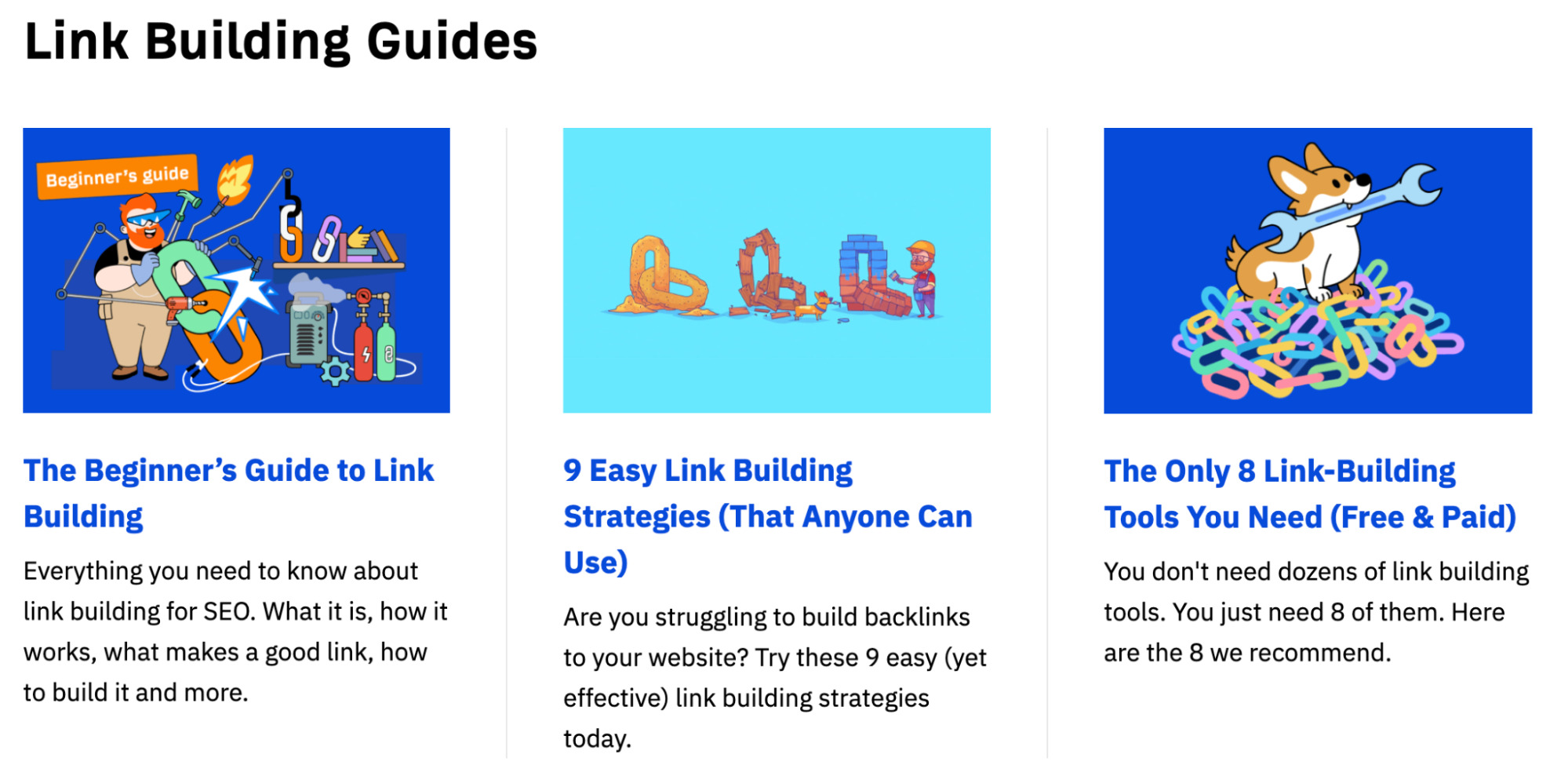
The key to making this work is to link between relevant pages. Ahrefs Site Audit identifies these automatically:
- Go Site Audit and choose the site you want to work on.
- Open the Internal link opportunities tool.

Pay particular attention to the source page, keyword context, and target page columns. These tell you which page to link from, link to, and where on the page to add the link.
For example, there are a few relevant internal links we can add from our list of SEO statistics:

A featured snippet answers the searcher’s question with a short answer. Example:

Since Google shows them on top of other results, this can be your shortcut to the very top.
You stand the best chance of winning the snippet for keywords where you rank 2-8, and Google already shows a featured snippet. Here’s how to find them:
- Go to Ahrefs’ Site Explorer and enter your domain.
- Open the Organic keywords report.
- Filter for Position 2-8 and SERP features where the target doesn’t rank.
- Sort the results by Volume high to low for prioritization.
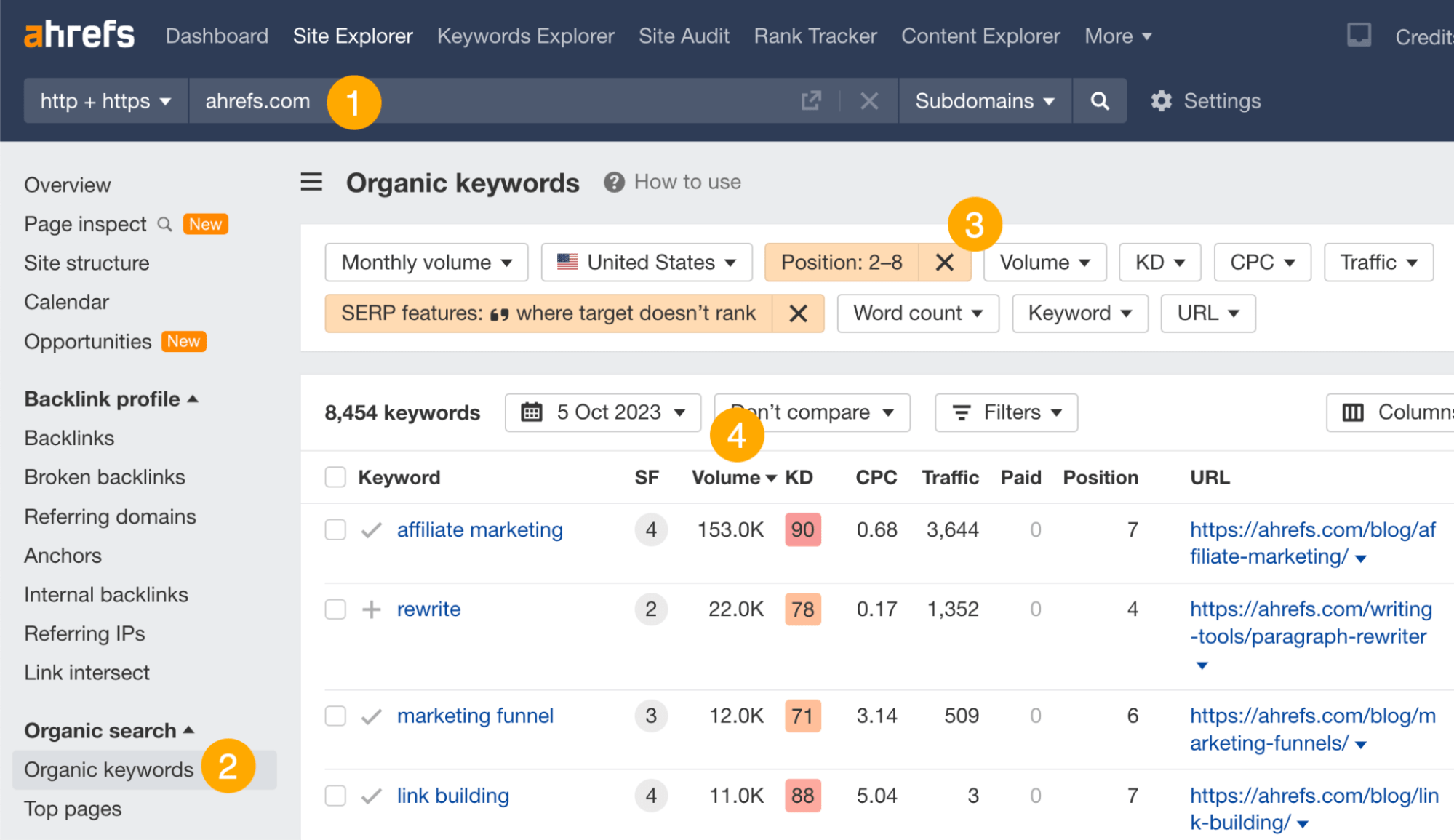
Winning the snippet comes down to providing more helpful information than what’s already ranking: fresher data, a more accurate answer, a more comprehensive definition of a term, etc.
Unfortunately, there is no silver bullet here, but you’ll find some good tips in our guide to featured snippets.
People want content in their native language when they search Google—even if their search is in English. Google knows this, and use’s the search’s location and language preference to personalize results.
For example, when I search for “link building,” I get Polish results. This is because Google knows I’m in Poland.

Despite us having a guide to link building, Google doesn’t rank it for me because it’s in English. By translating it into other languages, we could improve its reach and earn more organic traffic.
This is what we did for many of the posts on our English blog.
For example, the Spanish translation of our post about affiliate marketing brings in an estimated 8K organic visits each month.
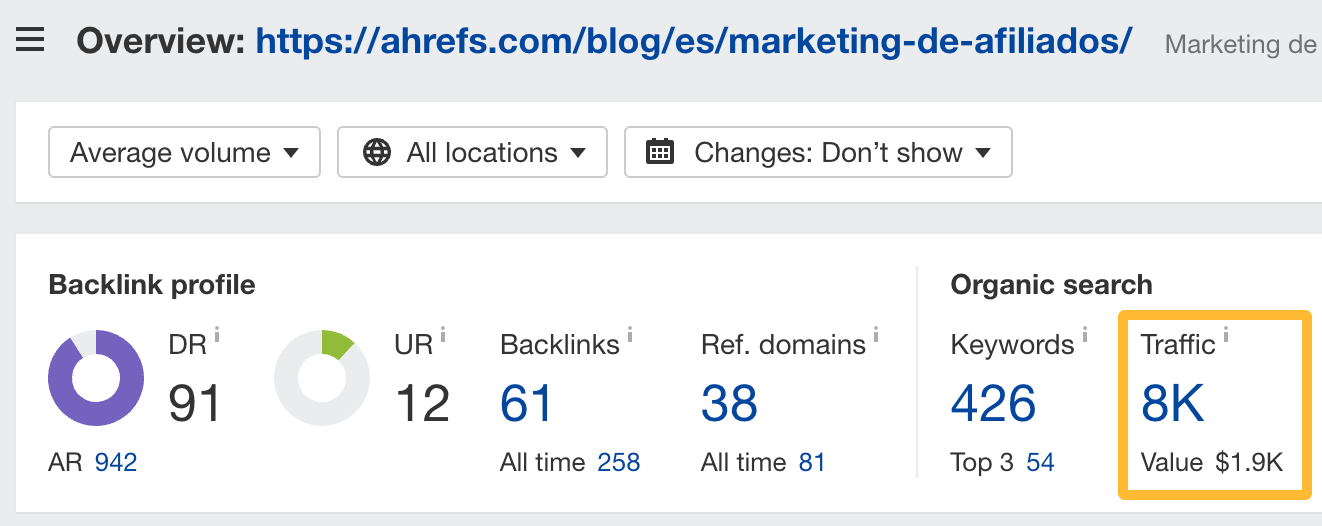
If you want to follow in our footsteps, the best way to get started is to translate your top-performing content. The idea here is that if people are searching for a topic in one language, there are probably people searching for it in other languages.
Here’s how to find your top-performing pages in organic search:
- Enter your domain into Ahrefs’ Site Explorer
- Go to the Top Pages report
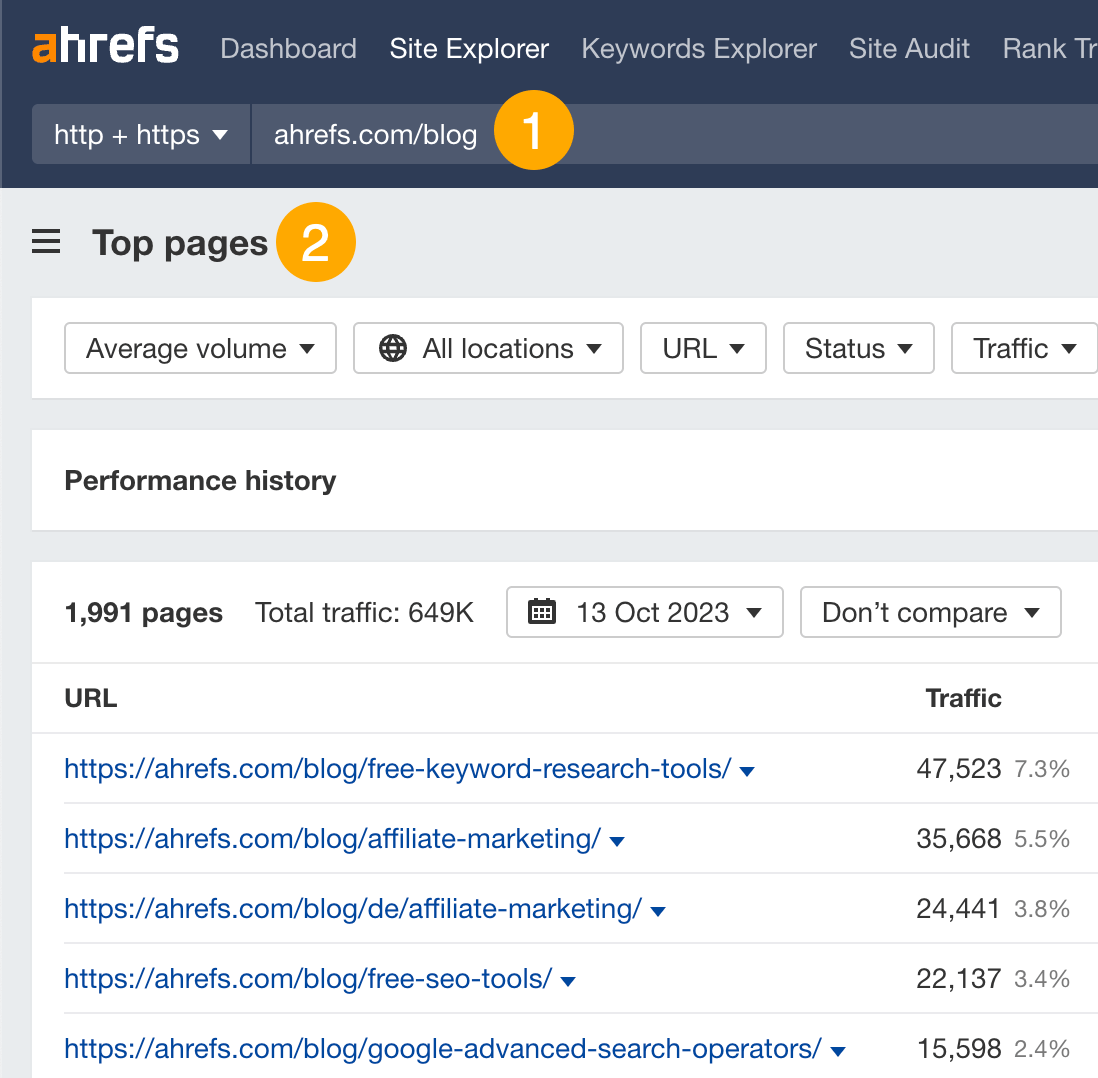
You can then ask ChatGPT how someone who speaks another language might search for the topic:

From there, you can simulate a local search for the topic in Google with Ahrefs SEO Toolbar and look at the estimated traffic to the top-ranking pages. This will help you to understand roughly how much traffic potential the topic has in that language and locale.
For example, the top-ranking post about free keyword research tools in French gets an estimated 714 organic monthly visits from France—so it might be worth translating:

If you can make your titles more compelling to the searchers, you can get more clicks even if your rank stays the same.
With this technique, you’re going to see the biggest lift in content that already brings you traffic. You can find these pages in the Top Pages report in Ahrefs’ Site Explorer, or Google Search Console click data.
For us, our list of free keyword research tools gets the most traffic:

Here’s our current title for that post:
The 9 Best Free Keyword Research Tools
Let’s see if ChatGPT can come up with something more interesting and enticing. Here’s the prompt I’ll use:
Give me 10 ways to make this title more interesting and enticing to click: “[current title]”. Keep them under 70 characters. Mention the keyword “[target keyword]” in each one.

I don’t love all of these, but “Boost SEO for Free: 9 Essential Free Keyword Research Tools” sounds like a slight improvement on our current title. It might be worth us switching it out and monitoring if there’s any increase in clicks.
Schema markup is code that helps Google understand the information on a page, which can be used to show rich results (also known as rich snippets).

As you can see above, results with schema are more visually compelling, and because of that, they can often earn more clicks.
Sidenote.
Schema is not a ranking factor. The idea here is to get more clicks to pages that already rank.
There are basically two ways of adding schema to your pages:
- Use your CMS or a plugin. Just fill out some information, and it’ll add the code for you.
- Use a schema markup generator. There are plenty of these around. Just Google it. The benefit here is that you can probably better customize your schema than in the first option. The downside is that you have to add the code yourself.
Either way, it’s always best practice to validate your code. Again, two options here:

You can find some more tips on SEO in:
Questions or comments? Find me on X.
SEO
Google Declares It The “Gemini Era” As Revenue Grows 15%

Alphabet Inc., Google’s parent company, announced its first quarter 2024 financial results today.
While Google reported double-digit growth in key revenue areas, the focus was on its AI developments, dubbed the “Gemini era” by CEO Sundar Pichai.
The Numbers: 15% Revenue Growth, Operating Margins Expand
Alphabet reported Q1 revenues of $80.5 billion, a 15% increase year-over-year, exceeding Wall Street’s projections.
Net income was $23.7 billion, with diluted earnings per share of $1.89. Operating margins expanded to 32%, up from 25% in the prior year.
Ruth Porat, Alphabet’s President and CFO, stated:
“Our strong financial results reflect revenue strength across the company and ongoing efforts to durably reengineer our cost base.”
Google’s core advertising units, such as Search and YouTube, drove growth. Google advertising revenues hit $61.7 billion for the quarter.
The Cloud division also maintained momentum, with revenues of $9.6 billion, up 28% year-over-year.
Pichai highlighted that YouTube and Cloud are expected to exit 2024 at a combined $100 billion annual revenue run rate.
Generative AI Integration in Search
Google experimented with AI-powered features in Search Labs before recently introducing AI overviews into the main search results page.
Regarding the gradual rollout, Pichai states:
“We are being measured in how we do this, focusing on areas where gen AI can improve the Search experience, while also prioritizing traffic to websites and merchants.”
Pichai reports that Google’s generative AI features have answered over a billion queries already:
“We’ve already served billions of queries with our generative AI features. It’s enabling people to access new information, to ask questions in new ways, and to ask more complex questions.”
Google reports increased Search usage and user satisfaction among those interacting with the new AI overview results.
The company also highlighted its “Circle to Search” feature on Android, which allows users to circle objects on their screen or in videos to get instant AI-powered answers via Google Lens.
Reorganizing For The “Gemini Era”
As part of the AI roadmap, Alphabet is consolidating all teams building AI models under the Google DeepMind umbrella.
Pichai revealed that, through hardware and software improvements, the company has reduced machine costs associated with its generative AI search results by 80% over the past year.
He states:
“Our data centers are some of the most high-performing, secure, reliable and efficient in the world. We’ve developed new AI models and algorithms that are more than one hundred times more efficient than they were 18 months ago.
How Will Google Make Money With AI?
Alphabet sees opportunities to monetize AI through its advertising products, Cloud offerings, and subscription services.
Google is integrating Gemini into ad products like Performance Max. The company’s Cloud division is bringing “the best of Google AI” to enterprise customers worldwide.
Google One, the company’s subscription service, surpassed 100 million paid subscribers in Q1 and introduced a new premium plan featuring advanced generative AI capabilities powered by Gemini models.
Future Outlook
Pichai outlined six key advantages positioning Alphabet to lead the “next wave of AI innovation”:
- Research leadership in AI breakthroughs like the multimodal Gemini model
- Robust AI infrastructure and custom TPU chips
- Integrating generative AI into Search to enhance the user experience
- A global product footprint reaching billions
- Streamlined teams and improved execution velocity
- Multiple revenue streams to monetize AI through advertising and cloud
With upcoming events like Google I/O and Google Marketing Live, the company is expected to share further updates on its AI initiatives and product roadmap.
Featured Image: Sergei Elagin/Shutterstock
SEO
brightonSEO Live Blog

Hello everyone. It’s April again, so I’m back in Brighton for another two days of Being the introvert I am, my idea of fun isn’t hanging around our booth all day explaining we’ve run out of t-shirts (seriously, you need to be fast if you want swag!). So I decided to do something useful and live-blog the event instead.
Follow below for talk takeaways and (very) mildly humorous commentary. sun, sea, and SEO!
SEO
Google Further Postpones Third-Party Cookie Deprecation In Chrome

Google has again delayed its plan to phase out third-party cookies in the Chrome web browser. The latest postponement comes after ongoing challenges in reconciling feedback from industry stakeholders and regulators.
The announcement was made in Google and the UK’s Competition and Markets Authority (CMA) joint quarterly report on the Privacy Sandbox initiative, scheduled for release on April 26.
Chrome’s Third-Party Cookie Phaseout Pushed To 2025
Google states it “will not complete third-party cookie deprecation during the second half of Q4” this year as planned.
Instead, the tech giant aims to begin deprecating third-party cookies in Chrome “starting early next year,” assuming an agreement can be reached with the CMA and the UK’s Information Commissioner’s Office (ICO).
The statement reads:
“We recognize that there are ongoing challenges related to reconciling divergent feedback from the industry, regulators and developers, and will continue to engage closely with the entire ecosystem. It’s also critical that the CMA has sufficient time to review all evidence, including results from industry tests, which the CMA has asked market participants to provide by the end of June.”
Continued Engagement With Regulators
Google reiterated its commitment to “engaging closely with the CMA and ICO” throughout the process and hopes to conclude discussions this year.
This marks the third delay to Google’s plan to deprecate third-party cookies, initially aiming for a Q3 2023 phaseout before pushing it back to late 2024.
The postponements reflect the challenges in transitioning away from cross-site user tracking while balancing privacy and advertiser interests.
Transition Period & Impact
In January, Chrome began restricting third-party cookie access for 1% of users globally. This percentage was expected to gradually increase until 100% of users were covered by Q3 2024.
However, the latest delay gives websites and services more time to migrate away from third-party cookie dependencies through Google’s limited “deprecation trials” program.
The trials offer temporary cookie access extensions until December 27, 2024, for non-advertising use cases that can demonstrate direct user impact and functional breakage.
While easing the transition, the trials have strict eligibility rules. Advertising-related services are ineligible, and origins matching known ad-related domains are rejected.
Google states the program aims to address functional issues rather than relieve general data collection inconveniences.
Publisher & Advertiser Implications
The repeated delays highlight the potential disruption for digital publishers and advertisers relying on third-party cookie tracking.
Industry groups have raised concerns that restricting cross-site tracking could push websites toward more opaque privacy-invasive practices.
However, privacy advocates view the phaseout as crucial in preventing covert user profiling across the web.
With the latest postponement, all parties have more time to prepare for the eventual loss of third-party cookies and adopt Google’s proposed Privacy Sandbox APIs as replacements.
Featured Image: Novikov Aleksey/Shutterstock
-

 PPC7 days ago
PPC7 days ago19 Best SEO Tools in 2024 (For Every Use Case)
-
SEARCHENGINES6 days ago
Daily Search Forum Recap: April 19, 2024
-
SEARCHENGINES7 days ago
Daily Search Forum Recap: April 18, 2024
-

 WORDPRESS6 days ago
WORDPRESS6 days agoHow to Make $5000 of Passive Income Every Month in WordPress
-

 WORDPRESS5 days ago
WORDPRESS5 days ago13 Best HubSpot Alternatives for 2024 (Free + Paid)
-

 SEO7 days ago
SEO7 days ago25 WordPress Alternatives Best For SEO
-

 WORDPRESS6 days ago
WORDPRESS6 days ago7 Best WooCommerce Points and Rewards Plugins (Free & Paid)
-

 MARKETING6 days ago
MARKETING6 days agoBattling for Attention in the 2024 Election Year Media Frenzy















